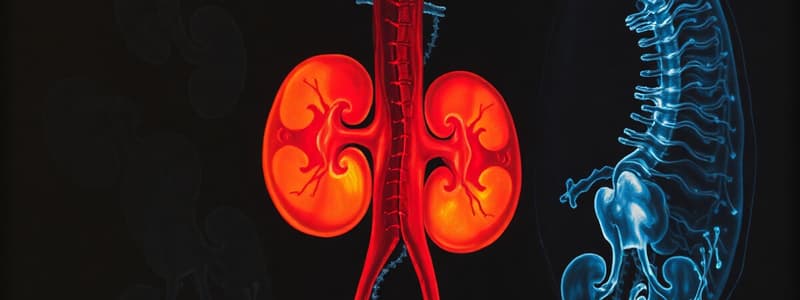Podcast
Questions and Answers
Which type of pain is typically associated with ureteric obstruction?
Which type of pain is typically associated with ureteric obstruction?
- Suprapubic pain
- Lower back pain
- Chronic abdominal pain
- Colicky loin pain (correct)
What is a common symptom associated with lower urinary tract issues?
What is a common symptom associated with lower urinary tract issues?
- Anuria
- Loin pain
- Nocturia (correct)
- Hematuria
Which urine abnormality is defined by the absence of urine production?
Which urine abnormality is defined by the absence of urine production?
- Oliguria
- Pollakiuria
- Nocturia
- Anuria (correct)
Which method is primarily used to estimate glomerular filtration rate (GFR)?
Which method is primarily used to estimate glomerular filtration rate (GFR)?
What aspect of renal diagnostics do nuclear medicine techniques primarily address?
What aspect of renal diagnostics do nuclear medicine techniques primarily address?
Flashcards
Renal Semiology
Renal Semiology
The study of the symptoms, physical findings, and clinical signs related to kidney and urinary tract disorders.
Loin Pain
Loin Pain
Pain that is felt in the back, specifically in the area of the kidneys (around the flanks). It's a common symptom of kidney issues.
Pollakiuria
Pollakiuria
Frequent urination, especially during the day.
Nocturia
Nocturia
Signup and view all the flashcards
Glomerular Filtration Rate (GFR)
Glomerular Filtration Rate (GFR)
Signup and view all the flashcards
Study Notes
Semiology and Kidney Function
- This lecture covers renal and urinary system symptoms, urine abnormalities, physical examination, volume assessment, kidney function measurement (GFR), and diagnostic imaging techniques.
Learning Objectives
- Recognize common symptoms and abnormalities of renal and urinary diseases.
- Understand glomerular filtration rate (GFR) and its estimation methods.
- Identify appropriate imaging modalities for renal diagnostics and their applications.
Key Concepts and Definitions
- Renal Semiology: Study of symptoms, physical findings, and clinical signs of kidney and urinary tract disorders.
- Pain Types: Loin pain (colicky, radiating to groin), suprapubic pain (lower urinary tract).
- Urine Abnormalities:
- Frequency: Pollakiuria (daytime), nocturia (nighttime).
- Volume: Anuria (<100 mL/day), oliguria (<400 mL/day), polyuria (>3 L/day).
- Composition: Hematuria (blood), proteinuria (proteins), pyuria (white cells), pneumaturia (gas).
- Voiding: Dysuria (painful), stranguria (painful, slow), hesitancy, urgency, enuresis.
- GFR (Glomerular Filtration Rate): Measure of kidney function; plasma cleared of a substance per unit time (indexed by body surface area 1.73 m²).
- Clearance: Volume of plasma cleared of a substance per unit time (using substances like inulin and creatinine to estimate GFR).
Imaging Techniques
- Ultrasound: First-line, real-time imaging (without radiation).
- CT: Detailed, contrast-enhanced anatomical imaging.
- MRI: Alternative to CT, avoiding radiation, useful for vascular evaluation.
- Nuclear Medicine: Functional imaging with radioisotopes.
Clinical Applications
- Case Study: Patient presenting with pollakiuria, nocturia, and colicky loin pain (possible nephrolithiasis).
- Diagnostic Approach: History (pain, frequency, volume, voiding symptoms), physical exam (inspection, palpation, percussion, auscultation, costovertebral angle tenderness), and investigations (urinalysis, imaging for anatomical/functional evaluation).
Treatment Options
- Nephrolithiasis: Pain management, hydration, possible lithotripsy.
- Urinary Tract Infection: Antibiotic therapy based on culture results.
- Fluid Overload: Monitoring volume status, managing with diuretics, fluid restriction if necessary.
Pathophysiology
- Renal Pain Pathway: Colicky pain from urinary tract obstruction (renal calculi).
- Volume Status and Edema: Reduced GFR can lead to fluid retention (peripheral edema).
- GFR Regulation: Compensatory hypertrophy of nephrons in response to declining numbers; notable nephron loss leads to decreased GFR only when compensatory mechanisms are overwhelmed.
Pharmacology
- Diuretics: Loop diuretics (fluid overload), Thiazide diuretics (lower BP).
- Nephrotoxins: Examples include NSAIDs and aminoglycosides, exacerbating renal dysfunction.
Differential Diagnosis
- Nephrolithiasis, Benign Prostatic Hyperplasia, Acute Kidney Injury.
Investigations
- Urinalysis: Detection of hematuria (glomerular or lower urinary tract) and proteinuria (glomerular).
- GFR Estimation: Creatinine clearance, CKD-EPI, MDRD equations.
- Imaging: Ultrasound (first-line for renal anatomy), CT urogram (detailed anatomical/obstructive evaluation), Nuclear Medicine (renal plasma flow/cortical function assessment).
Studying That Suits You
Use AI to generate personalized quizzes and flashcards to suit your learning preferences.





